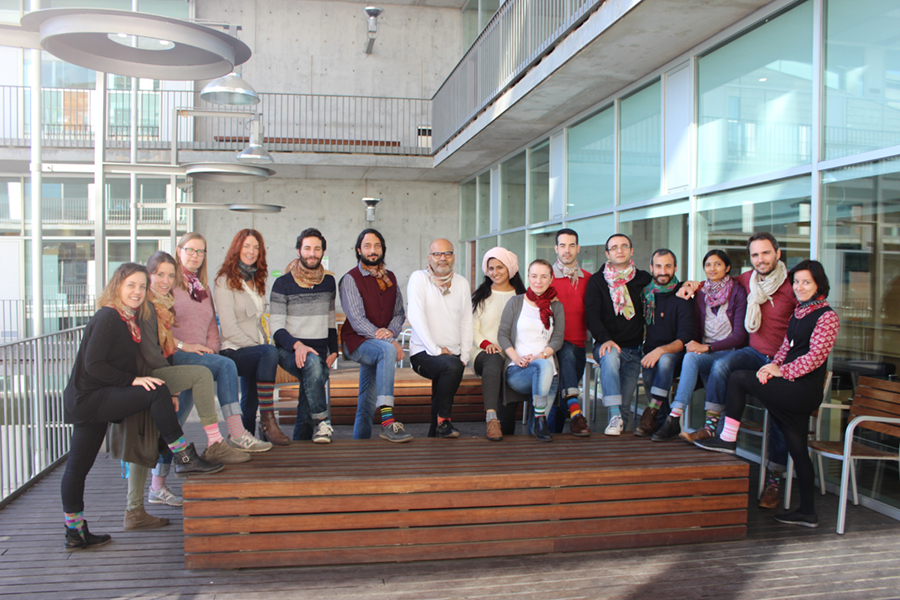Mechanism of mega cargo export from the ER
In 2009, we reported the requirement of TANGO1 in procollagen VII export from the ER (Saito et al., 2009). TANGO1 is one of the genes that we had identified in a genome wide screen for new components involved in Transport ANd Golgi Organization (Bard et al., 2006). Surprisingly, we discovered that membrane fusion proteins were required for collagen export from the ER (Nogueira et al., 2014). We found that a domain of TANGO1 recruited ERGIC53 containing membranes derived from the ER-Golgi intermediate compartment to collagen-enriched patches in the ER (Santos et al., 2015). Our findings reveal that ERGIC membrane is added to the ER at the site of collagen export so that the nascent carrier can accommodate collagen. In other words, membranes fuse with a collagen-enriched patch of the ER to promote growth of the export carrier. Altogether, we suggest that TANGO1 recruits collagen in the lumen of the ER and generates a collagen-enriched domain. The cytoplasmic domain of TANGO1 recruits inner COPII coat proteins Sec23/24 and ERGIC membranes. ERGIC membranes are used to generate a mega tubule. Our new data reveal that TANGO1, at the ER, assembles in a ring that encircles COPII components. The C-terminal, proline rich domains (PRD) of TANGO1 molecules in the ring are initially tilted onto COPII coats, but appear pushed apart as the carrier grows. These findings lend support to our suggestion that growth of transport carriers for exporting bulky cargoes requires addition of membranes and not simply by COPII mediated accretion of a larger surface of ER. TANGO1 remains at the neck of the newly forming transport carrier, which grows in size by addition of ERGIC-53-containing membranes to generate a transport intermediate for the export of bulky collagens. We have identified a TANGO1 like protein (TALI) that functions in the export of extremely bulky lipoprotein particles called chylomicrons from the ER. The basic mechanism of TALI function is the same as TANGO1except that the former binds ApoB coated lipid particles called chylomicrons and the later interacts with collagens (Santos et al., 2016). So, TANGO and TALI provide a means to understand the mechanism by which homeostasis of extracellular matrix (through collagen export and assembly) and cholesterol and dietary lipid (secreted chylomicrons traffic these components across tissues) is regulated in health and disease. Our new findings reveal that TANGO1 assembles into a ring at ERES to partition the activities associated with cargo export from the rest of ER (Raote et al., 2017; Raote et al., 2018). Our studies are now geared to understanding the structural aspect of TANGO1 and TANGO1. WE have also expressed TANGO1 in the ER of yeast and our aim is to continue with engineering yeast to reconstitute the collagen export machinery.
Mechanism of unconventional protein secretion
We have known for 2 decades that eukaryotic cells secrete proteins that cannot enter the ER-Golgi pathway of conventional protein secretion. My lab is the first to identify a protein, called GRASP that is a component of the unconventional protein secretion pathway (Kinseth et al., 2007). In 2010, we reported the involvement of large number of new genes in this pathway (Duran et al., 2010). We identified a previously unknown organelle, called CUPS, that contains GRASP and forms under conditions that promote unconventional secretion (Bruns et al., 2011). Our new findings reveal that cells collect membranes from late Golgi and endosomes to generate CUPS during nutrient starvation in yeast. Interestingly, upon returning to normal growth conditions, CUPS fuse with the ER by a COPI dependent reaction. By this procedure, CUPS function during starvation and then, upon return to normal conditions, return components that had been barrowed from the late Golgi and endosomes by standard COPII mediated export from the ER (Cruz et al., 2014). More recently, we have reconstituted the unconventional protein secretion in yeast by a quantitative procedure. This procedure has confirmed the involvement of GRASP protein and revealed the requirement of ESCRT proteins of the multivesicular body pathway. Surprisingly, however, the key component of the MVB pathway, Vps4, is not involved in unconventional protein secretion. Altogether, our findings suggest a CUPS dependent, but MVB independent pathway of protein secretion (Curwin et al., 2016). We have also identified a number of new proteins that are secreted unconventionally, which should help in identifying a common signal that governs recruitment of cargoes into this pathway of secretion (Cruz et al., 2017). These findings are thus beginning to unravel a novel pathway by which cells secrete essential cytokines, growth factors, adipokines, diazepam binding inhibitor, SOD1, and tissue transglutaminase in a signal dependent manner.
Mechanism of mucous homeostasis
Dysregulation of mucin secretion is a major issue in human pathologies of chronic obstructive pulmonary disease (COPD: hyper secretion of mucins) and Crohn’s disease (hypo secretion of mucins). We performed a genome wide screen and identified 19 new genes required for mucin secretion. This pool included a gene called TRPM5, which upon stimulation by extracellular ATP promoted Na2+ entry into cells to trigger Ca2+ flux via the sodium/calcium exchanger (NCX). Inhibition of TRPM5 and NCX inhibited mucin (Muc5Ac) secretion (Mitrovic et al., 2013). Our new results reveal that NCX is also necessary for mucin secretion by cells of the respiratory lining of patients with cystic fibrosis (Cantero et al., in review). Collectively, these genes are unravelling the mechanism of mucin secretion and our approaches also have the potential of generating valuable therapeutics.
